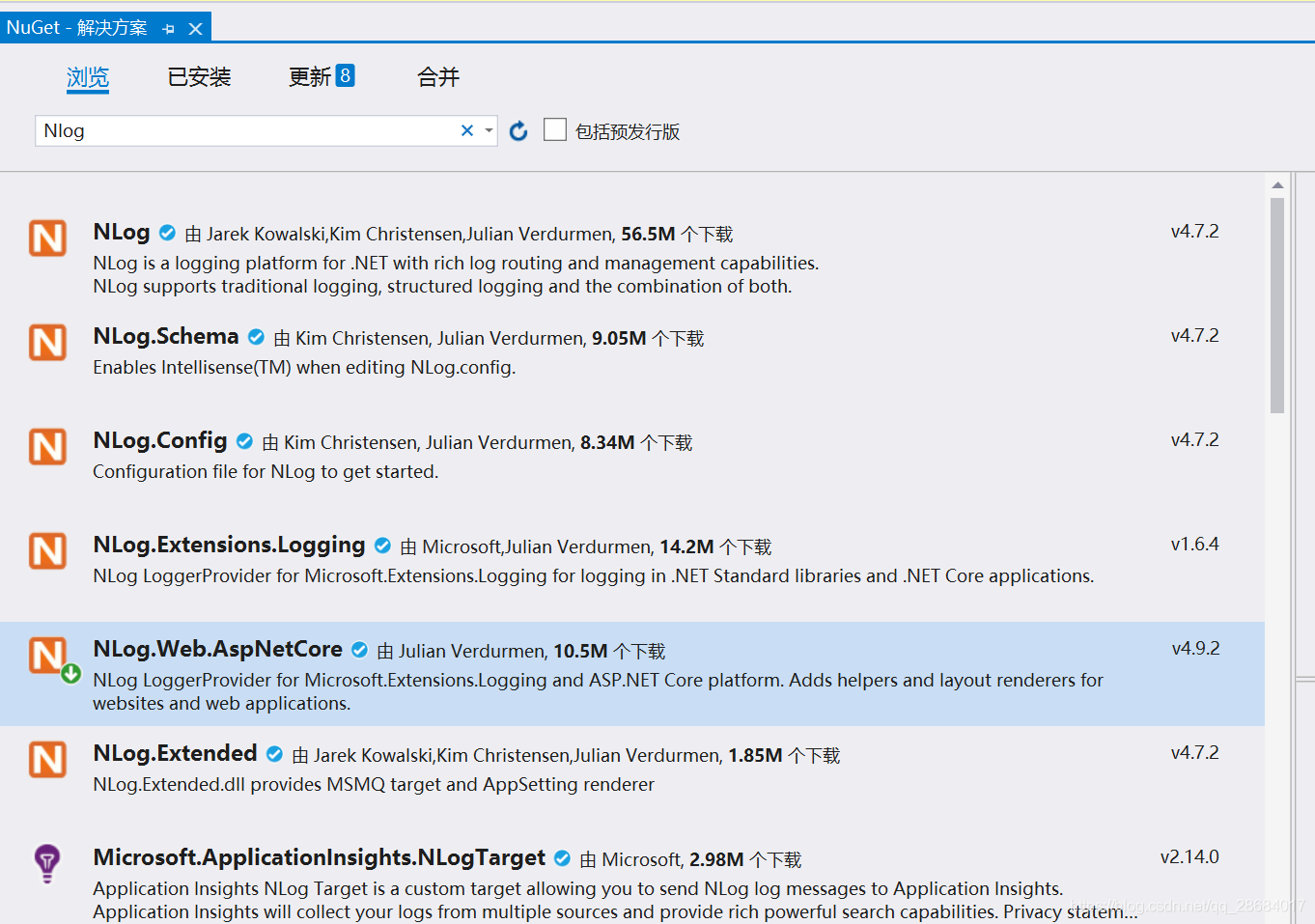1、安装和使用Influxdb
安装部分网上资料比较多,也讲的比较详细,请自行百度。
下面大概讲下InfluxDB的写入和读取数据的方法。
我使用了InfluxData.Net包。
工具-》NuGet包管理器-》管理解决方案的NuGet程序包-》浏览-》输入InfluxData.Net。

安装好之后就可以写代码了
其中注意几点坑
1、InfluxDB的time格式是世界标准时区时间,所以我在其基础上加了8小时,具体请看下面的代码。
2、插入和查询数据时,语句中不能包含引号“”、‘’,这和InfluxDB的行协议有关,如果插入的数据中包含引号,一定要进行转义。例如 "weather"
3、查询后的数据格式和其他数据库不一致,格式如下。我提供了两种解析方法(输出List或json字符串)

代码如下:
using InfluxData.Net.Common.Enums;
using InfluxData.Net.InfluxDb;
using InfluxData.Net.InfluxDb.Models;
using System;
using System.Collections.Generic;
using System.Data;
using System.Diagnostics.Eventing.Reader;
using System.Linq;
using System.Threading.Tasks;
using InfluxData.Net.Common.Helpers;
namespace test
{
public class InfluxDbRepository
{
private readonly InfluxDbClient _clientDb;
private readonly IInfluxDbConfig _influxDbConfig;
public InfluxDbRepository(IInfluxDbConfig influxDbConfig)
{
_influxDbConfig = influxDbConfig;
var influxUrl = _influxDbConfig.Get().InfluxUrl;
var influxUser = _influxDbConfig.Get().InfluxUser;
var influxPwd = _influxDbConfig.Get().InfluxPwd;
//创建InfluxDbClient实例
_clientDb = new InfluxDbClient(influxUrl, influxUser, influxPwd, InfluxDbVersion.Latest);
}
/// <summary>
/// 写入单个对象
/// </summary>
/// <param name="entities"></param>
/// <param name="baseLog">基本信息</param>
/// <returns></returns>
public async System.Threading.Tasks.Task InsertAsync(BaseLog baseLog)
{
try
{
var tags = new Dictionary<string, object>();
var fields = new Dictionary<string, object>();
var propertyInfos = ForeachClassHelper.ForeachClassProperties<BaseLog>(baseLog);
foreach (var item in propertyInfos)
{
fields.Add(item.Name, item.GetValue(baseLog, null));
}
var pointModel = new Point()
{
Name = _influxDbConfig.Get().TableName,//表名
Tags = tags,
Fields = fields,
Timestamp = DateTime.UtcNow.AddHours(8)
};
var response = await _clientDb.Client.WriteAsync(pointModel, _influxDbConfig.Get().DbName);
}
catch (Exception ex)
{
throw;
}
}
/// <summary>
/// 从InfluxDB中读取数据 返回string,和返回List的性能几乎一样
/// 测试6万条数据 1s
/// </summary>
public async Task<string> GetDataAsync(string sql)
{
try
{
//传入查询命令,支持多条
var queries = new[] { sql };
var dbName = _influxDbConfig.Get().DbName;
Stopwatch sw = new Stopwatch();
sw.Start();
//从指定库中查询数据
var response = await _clientDb.Client.QueryAsync(queries, dbName);
sw.Stop();
long dur = sw.ElapsedMilliseconds;
//得到Serie集合对象(返回执行多个查询的结果)
var series = response.ToList();
string rtn;
if (series.Any())
{
var dt = new DataTable();
//取出第一条命令的查询结果,是一个集合
var column = series[0].Columns;
foreach (var item in column)
{
dt.Columns.Add(item, typeof(string));
}
var list = series[0].Values;
foreach (var row in list)
{
DataRow dr = dt.NewRow();
for (int i = 0; i < row.Count; i++)
{
dr[i] = row[i];
}
dt.Rows.Add(dr);
}
rtn = SerializeHelper.ToJson(dt);
}
else
{
rtn = "";
}
return rtn;
}
}
/// <summary>
/// 查询 返回List
/// </summary>
/// <typeparam name="T"></typeparam>
/// <param name="sql"></param>
/// <returns></returns>
public async Task<List<T>> GetDataListAsync<T>(string sql) where T : new()
{
try
{
//传入查询命令,支持多条
var queries = new[] { sql };
var dbName = _influxDbConfig.Get().DbName;
//从指定库中查询数据
var response = await _clientDb.Client.QueryAsync(queries, dbName);
//得到Serie集合对象(返回执行多个查询的结果)
var series = response.ToList();
List<T> listrtn = new List<T>();
if (series.Any())
{
//取出第一条命令的查询结果,是一个集合
var column = series[0].Columns.ToList();
var list = series[0].Values;
for (int i = 0; i < list.Count(); i++)
{
var temp = new T();
var propertyInfos = ForeachClassHelper.ForeachClassProperties<T>(temp);
foreach (var item in propertyInfos)
{
if (item.Name != "time")
{
int index = column.FindIndex(x => x.Equals(item.Name));
if (index != -1)
{
item.SetValue(temp, list[i][index], null);//给对象赋值
}
}
}
listrtn.Add(temp);
}
}
else
{
listrtn = null;
}
return listrtn;
}
}
}
}
2、使用Nlog
2.1 安装Nlog
新建项目后,工具-》NuGet包管理器-》管理解决方案的NuGet程序包

选择Nlog进行安装,如果是.net core项目就选择Nlog.Web.AspNetCore。
2.2 配置Nlog
配置内容写在Nlog.config里边。主要用到两个标签:
Target:这个是主要用来配置日志输出的相关参数的,比如输出到文件、控制台还是数据库,输出的文件名称是什么,内容格式是什么等。
Rules:输出规则,定义根据不同的日志级别输出到不同的地方,比如Info类型的输出到文件,Error类型的通过邮件发送处理等。
详细的配置内容参考官方文档: https://github.com/nlog/NLog/wiki/Configuration-file.
下面是一个简单的配置
<?xml version="1.0" encoding="utf-8" ?>
<nlog xmlns="http://www.nlog-project.org/schemas/NLog.xsd"
xmlns:xsi="http://www.w3.org/2001/XMLSchema-instance"
xsi:schemaLocation="http://www.nlog-project.org/schemas/NLog.xsd NLog.xsd"
autoReload="true"
throwExceptions="false"
internalLogLevel="Off" internalLogFile="c: emp
log-internal.log">
<variable name="myvar" value="myvalue"/>
<targets>
<target xsi:type="File" name="file" fileName="${basedir}/Logs/${date:format=yyyyMM}/${shortdate}.txt"
layout="
${newline}时间: ${longdate}
${newline}来源: ${callsite}
${newline}等级: ${level}
${newline}信息: ${message}
${newline}堆栈: ${event-context:item=exception} ${stacktrace}
${newline}${newline}-----------------------------------------------------------" />
<target name="console" type="Console" layout="${longdate} ${callsite} ${level} ${message}${newline}" />
</targets>
<rules>
<logger name="*" writeTo="file" />
<logger name="*" minlevel="Trace" writeTo="console" />
</rules>
</nlog>
如果要讲日志输出到InfluxDB这种非标准输出,则需要扩展,编写自定义目标
下面是拓展步骤
2.2.1 编写自定义目标
1、创建一个继承自的类 NLog.Targets.TargetWithLayout
2、覆盖Write()方法。
3、在此方法的主体中,调用this.Layout.Render()以获取消息文本,然后将文本发送到目标媒体。
代码如下:
using NLog;
using NLog.Config;
using NLog.Targets;
using System;
using System.Collections.Generic;
using System.Text;
using Microsoft.Extensions.DependencyInjection;
namespace test
{
/// <summary>
/// 自定义Nlog写入目标-InfluxDB
/// </summary>
[Target("InfluxDB")]
public class InfluxDBTarget: TargetWithLayout
{
public InfluxDBTarget()
{
}
protected override void Write(LogEventInfo logEvent)
{
//获取消息文本
string logMessage = this.Layout.Render(logEvent);
//反序列化
BaseLog baseLog = SerializeHelper.FromJson<BaseLog>(logMessage);
//将日志内容保存到InfluxDB数据库
var repository = AppStartup.App.ServiceProvider.GetService<InfluxDbRepository>();
repository.InsertAsync(baseLog);
}
private void InsertInfluxDB(string message)
{
// TODO - write me
}
}
}
2.2.2 配置输出内容InfluxDB
在Nlog.config中配置输出内容,配置如下
<?xml version="1.0" encoding="utf-8" ?>
<nlog xmlns="http://www.nlog-project.org/schemas/NLog.xsd" xmlns:xsi="http://www.w3.org/2001/XMLSchema-instance"
throwExceptions="true">
<extensions>
<!--这里是上面InfluxDBTarget所在程序集的名称-->
<add assembly="test" />
</extensions>
<targets async="true">
<target name="database" type="InfluxDB" >
<layout xsi:type="JsonLayout">
<attribute name="ProcessId" layout="${processid}" />
<attribute name="Level" layout="${level}"/>
<attribute name="AppDomain" layout="${appdomain}" />
<attribute name="MachineName" layout="${machinename}" />
<attribute name="Message" layout="${message}"/>
<attribute name="AssemblyVersion" layout="${assembly-version}" />
<attribute name="ProcessName" layout="${processname}" />
<attribute name="CallSite" layout="${callsite}"/>
<attribute name="CallSiteLinenumber" layout="${callsite-linenumber}" />
<attribute name="ThreadId" layout="${threadid}" />
<attribute name="Exception" layout="${exception}"/>
<attribute name="IP" layout="${aspnet-request-ip}" />
<attribute name="LongDate" layout="${longdate}" />
<attribute name="StackTrace" layout="${stackTrace}"/>
</layout>
</target>
</targets>
<rules>
<logger name="*" minlevel="Trace" writeTo="database" />
</rules>
</nlog>
到这Nlog部分就结束了
InfluxDB Studio查询日志内容
